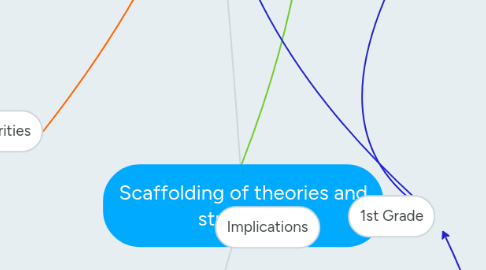
1. Developmentally appropriate education
1.1. De-emphasis on making children think like adults
1.2. Focuses on the process of thinking
1.3. Active learning
1.4. Differ enation of learning
2. Piaget
2.1. How development occurs
2.2. Schemes
2.2.1. Mental patterns that guide behavior
2.3. Adaptation
2.3.1. Process of adjusting schemes in response to the environment by means of assimulation and accomodation
2.4. Assimilation
2.4.1. Understsnding new experiences in terms of existing schemes
2.5. Accomodation
2.5.1. Modifying exsiting schemes to fit new situatons
2.6. Equilibration
2.6.1. The process of restoring balance between present understanding and new experiences
2.7. Constructivism
2.7.1. View of cognitive development that emphasizes the active role of learners in building their own understanding of reality
3. Stages of Development
3.1. Sensorimotor stage 0 – 2 yrs.
3.1.1. Use senses and motor skills
3.1.2. Use reflexes to respond to stimuli
3.1.3. Moving from trial and error to more planned problem solving
3.1.4. Develops object permanence
3.1.5. Goal directed behavior
3.2. Preoperational 2- 7 yrs.
3.2.1. Lack understanding of conservation
3.2.2. Ability to think about things and use symbols to represent objects in the mind
3.2.3. Large focus on the use of centration
3.2.4. Lack of the ability of reversibility
3.2.5. Egocentric in their thinking
3.3. Concrete operational 7 – 11 yrs.
3.3.1. Children develop the capacity of logical reasoning and conservation
3.3.2. Have acquired the concept of reversibility
3.3.3. Able to respond to inferred reality
3.3.4. Learned the task of seriation
3.3.5. Have moved from egocentric thought to decentered thought
3.3.6. Have mastered the skill of transitivity
3.4. Formal Operational 11- Adult
3.4.1. Begins in puberty
3.4.2. Can deal with abstract thoughts and hypothetical situations
3.4.3. Systematic thinking
3.4.4. Have mastered transitivity and can self-monitor thinking
3.4.5. Systematic thinking
4. Criticisms
4.1. Tasks can be taught at earlier stages
4.2. Children’s skills develop in different ways on different tasks
4.3. Experiences influences their stages of development
5. Implications
6. Vygotsky
7. Main Ideas
7.1. Learning precedes development
7.2. Learning involves the acquisition of signs by means of information from others and deliberate teaching
8. How development occurs
8.1. Self-regulation
8.1.1. Learned that actions and sounds have meanings
8.1.2. Practice action and language
8.1.3. Use signs to think and solve problems without the help of others
8.1.4. Children use private speech
8.2. Zone of proximal development
8.2.1. Master communications systems and use systems to regulate thought
8.2.2. Task that cannot be accomplish alone but could with assistance
8.2.3. Teacher sets goals for students needs
8.2.4. Teacher scaffolds learning and learner develops new knowledge
8.3. Scaffolding
8.3.1. Assistance that is provided by more competent peer or adult
8.3.2. Utilizes clues, reminders, encouragement, examples, “breaking problems down into steps”
8.3.3. High level of teacher support
8.3.4. Over time student becomes and independent learner.
8.4. Cooperative learning
8.4.1. Children working together to help one another.
9. Similarities
9.1. Both were constructivists
9.2. Both believe that social forces sets the limit of development
9.3. Development occurs because child is an active learner
9.4. Egocentric speech is important
10. Reading
11. A typical behavior
11.1. Poor phonological/phonemic awareness
11.2. Unable to blend and segment sounds and words
11.3. Difficulty decoding words
11.4. Unable to develop meaning from print
12. Typical Behavior
12.1. Saying the sounds of letters
12.2. Blending sounds into decodable words
12.3. Realizing that print has meaning
12.4. Segmenting words
13. Strategies
13.1. Model how to blend and segment sounds
13.2. Early identification
13.2.1. RTI, progress monitoring
13.3. Provide feedback and opportunities for practice
13.4. Develop fluency
13.4.1. Repeated reading, choral repeated reading, guided reading
13.5. Explicit and implicit code instruction
13.5.1. Word families
13.5.2. Reading mastery and corrective reading
13.5.3. Sight word association
13.6. Comprehension development
13.6.1. KWL charts
13.6.2. Brainstorming
13.6.3. Text preview
13.6.4. QAR
13.6.5. Mind Maps
14. Development
14.1. Able to access prior knowledge
14.2. Can visualize
14.3. Make predictions
14.4. Monitor and check understanding
14.5. Use context clues for figuring out unknown words
14.6. Use word parts
15. Instruction
15.1. Teach phonological awareness and phonics
15.2. Structural analysis
15.3. High frequency words
15.4. Onset-Rime for decoding words by blending
15.5. Syllabication
16. Writing
17. Typical
17.1. Inventive spelling
17.2. Write about topics that are meaningful to them
17.3. Try to use some punctuation and capitalization
17.4. Handwriting is somewhat legible
18. Atypical
18.1. No knowledge of phonological awareness to aid in spelling
18.2. Lack prior knowledge or experiences that can aid in writing brainstorming
18.3. No knowledge of grammar rules
18.4. Handwriting is poor and laborious
19. Strategies
19.1. Dictation
19.2. Graphic organizers
19.2.1. Brainstorming webs
19.2.2. Paragraph hamburger
19.3. Provide story starters/prompts
19.4. Raised paper/spacers for improving handwriting
19.5. Framed paragraphs
20. Development
20.1. Spelling common high frequency words
20.2. Use correct grammar and punctuation
20.3. Write legibly
20.4. Use appropriate and varied word choice
20.5. Able to write for a purpose
20.6. Use complete sentences
21. Instruction
21.1. Modeling strategies during guided practice
21.2. Teach students to write for various purposes
21.3. Use exemplary texts as examples of good writing
21.4. Give students opportunities to share writing
22. Vocabulary
23. Typical
23.1. Able to build word understanding from everyday situations or through reading
23.2. Use syntactic cues to match word meanings
23.3. Uses skills learned in reading to help decode meanings of words
24. A typical
24.1. No knowledge of a word or word meanings
24.2. Weakness in phonemic awareness, phonics and word analysis skills
24.3. Lack of exposure to varying vocabulary
25. Strategies
25.1. Word walls
25.2. Picture walks
25.3. Word maps
25.3.1. Frayer model
25.4. Active engagement
25.4.1. Songs/dances, snap and clap
25.5. Teaching word structure
25.5.1. Synonyms/antonyms
